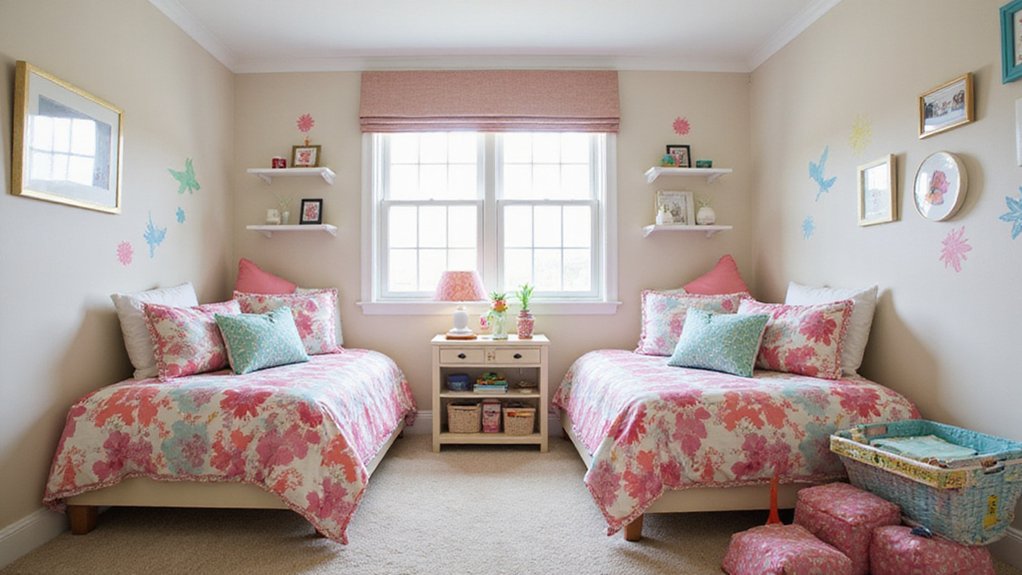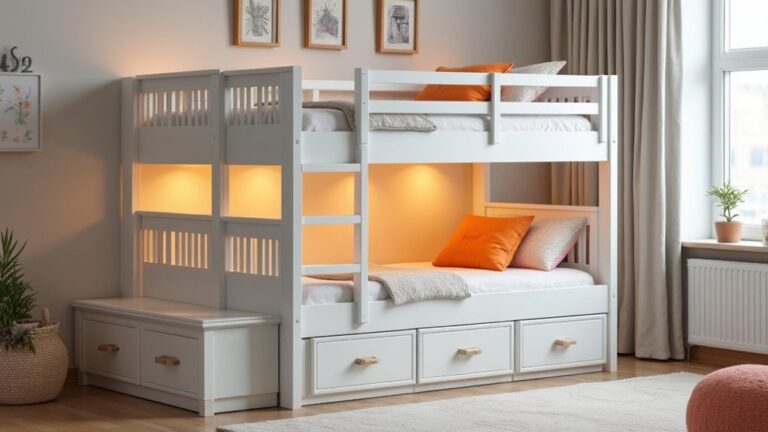Getting two kids to happily share a bedroom feels like negotiating a peace treaty betweenrival nations. I’ve watched parents transform potential sibling warfare into harmonious coexistence with the right design strategies, and honestly, it’s pretty magical when you nail the balance between shared space and personal territory.
You clicked here because you’re probably staring at a room wondering how on earth you’ll make this work without constant battles over space, belongings, or privacy. The secret lies in creating distinct zones using clever room dividers like bookshelves or curtains, designing matching bed frames with personalized bedding that celebrates each child’s unique personality, and installing smart double-duty storage solutions like cube organizers and under-bed drawers.
The game-changer? Color coding individual spaces to reduce those “that’s mine!” arguments, plus custom bunk beds with built-in privacy features for smaller rooms. These strategies don’t just maximize space—they help each kid feel like they have their own special corner of the world while learning to share beautifully.
Create Distinct Zones With Strategic Room Dividers

Siblings sharing a bedroom need their own personal space, even within the same four walls. Strategic room dividers create distinct zones without expensive renovations.
Install a bookshelf perpendicular to the wall, doubling as storage and separation. Hang curtains from ceiling tracks for flexible privacy that’s easily adjustable.
Position twin beds on opposite walls with a tall dresser between them. Create visual boundaries using different paint colors or wallpaper on each side. Portable folding screens work perfectly for renters.
These solutions give each child ownership of their designated area while maintaining the room’s functionality and flow.
Design Matching Beds With Personalized Bedding

While maintaining visual cohesion throughout the room, you’ll want to choose matching bed frames that create a unified foundation for each child’s personal expression.
Select identical frames in neutral colors like white or natural wood, then let each twin’s personality shine through customized bedding choices. This approach maintains harmony while celebrating individuality.
Consider these personalization strategies:
- Color coordination – Choose complementary colors that work together but reflect each child’s preferences
- Pattern mixing – Pair stripes with polka dots or florals with geometric designs
- Themed bedding – Let one choose dinosaurs while the other picks unicorns
- Monogrammed pillows – Add initials for a custom touch
Install Double-Duty Storage Solutions That Prevent Fights

How can you eliminate storage disputes before they start? Create identical storage systems for each twin. Install matching cube organizers, under-bed drawers, and wall-mounted shelves on each side of the room. You’ll prevent arguments when both kids have equal space for toys, books, and belongings.
Choose storage that serves multiple purposes. Ottoman storage benches provide seating and hide clutter. Bed frames with built-in drawers maximize floor space. Wall pockets organize small items while displaying artwork.
Label each twin’s storage areas clearly. Use photos for non-readers and color-coding systems. When everything has a designated spot, you’ll reduce conflicts and teach organizational skills simultaneously.
Use Color Coding to Define Individual Spaces
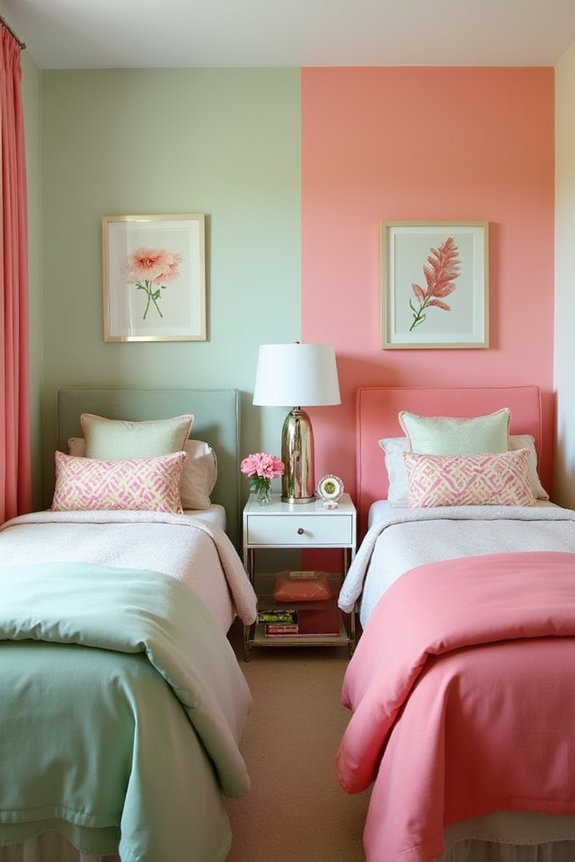
Color coding transforms a shared bedroom into clearly defined personal territories without building physical barriers. You’ll create visual boundaries that kids understand instantly while maintaining room harmony.
Assign each child their signature color and implement it strategically:
- Bedding sets – Choose coordinating colors that complement each other rather than clash
- Storage bins and baskets – Label with matching colored tape or paint for instant identification
- Wall accents – Paint one accent wall per side or add colored decals behind each bed
- Personal accessories – Desk lamps, picture frames, and hooks in their designated colors
This system reduces arguments over belongings while teaching organizational skills.
Build Custom Bunk Beds With Privacy Features

Custom bunk beds maximize floor space while giving each child their own private retreat within the shared room. You’ll want to incorporate built-in curtains or sliding panels that create instant privacy when needed.
Consider adding individual reading lights, small shelves, and charging stations to each bunk level. Install sound-dampening materials between the beds to minimize noise transfer. Design separate ladder access points so kids won’t disturb each other during nighttime trips.
Include personal storage cubbies within arm’s reach of each bed. These thoughtful features transform basic bunk beds into personalized sanctuaries where twins can enjoy both togetherness and independence.
Designate Personal Display Areas for Each Child
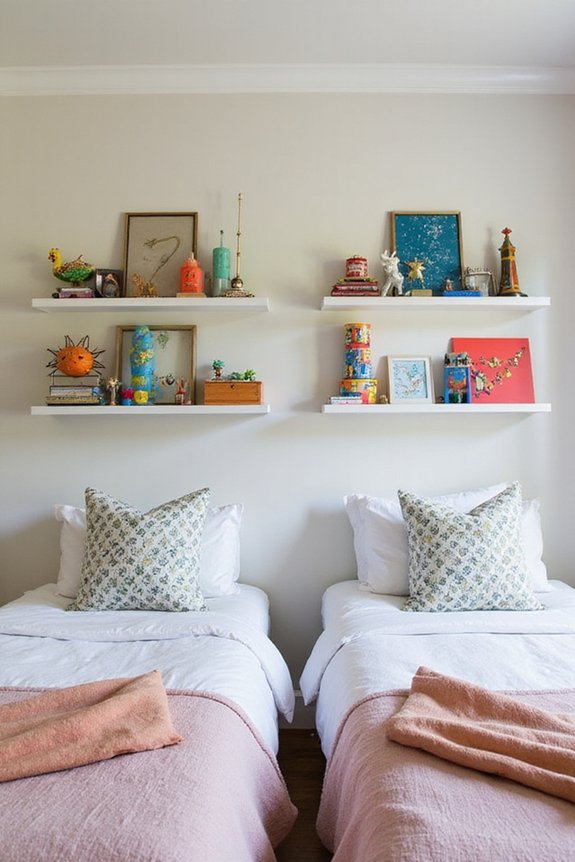
Personal display areas give each twin ownership over specific spaces where they can showcase their individual interests, achievements, and treasured belongings.
You’ll create harmony by establishing clear boundaries for each child’s personal zone. These dedicated spaces prevent arguments while encouraging self-expression and pride in their accomplishments.
Consider these effective display solutions:
- Individual floating shelves mounted above each bed for trophies, books, and collectibles
- Cork boards or magnetic boards positioned at each child’s eye level for artwork and photos
- Shadow boxes installed on the wall to display three-dimensional keepsakes and mementos
- Desktop display stands on separate desks for rotating seasonal collections
Incorporate Flexible Furniture That Grows With Them

When twins share a bedroom, investing in adaptable furniture prevents costly replacements as they move from toddlers to teenagers. Choose convertible cribs that transform into toddler beds, then full-size beds.
Adjustable-height desks accommodate growing children and changing homework needs. Modular storage systems let you reconfigure shelving as interests evolve from toys to books to sports equipment.
Bunk beds with removable ladders can separate into individual beds when space allows. Look for wardrobes with adjustable shelving and removable dividers. Ottoman storage doubles as seating and toy boxes.
You’ll save money while ensuring the room remains functional throughout their developmental stages.
Plan Separate Study Nooks for Homework Time
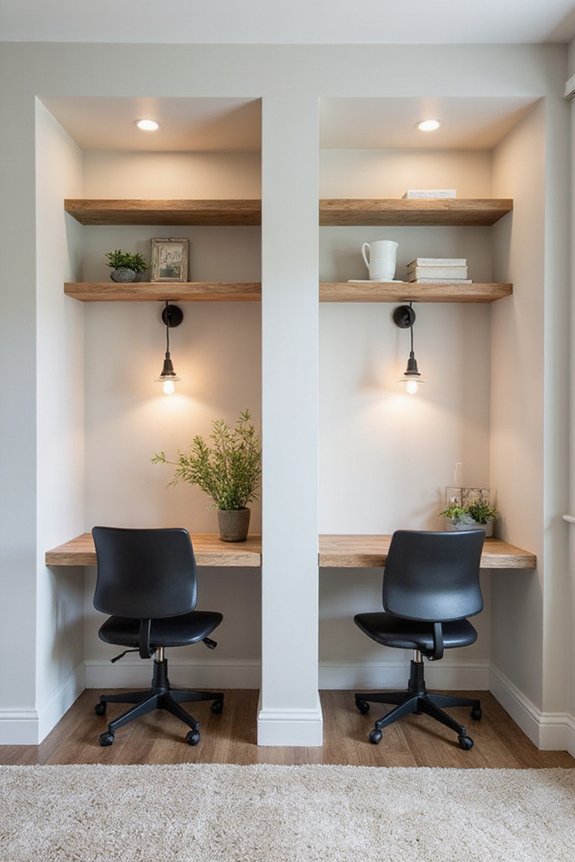
Beyond selecting adaptable furniture, creating dedicated homework spaces helps twins focus on their studies without distracting each other.
You’ll want to establish separate zones where each child can concentrate. Consider these practical study nook solutions:
- Corner desks – Position individual workstations in opposite room corners to minimize visual distractions
- Built-in window seats – Transform windowsills into cozy study spots with cushions and storage underneath
- Loft bed integration – Install desks directly below elevated beds for space-efficient homework areas
- Portable study carts – Use rolling carts that can move to quiet spots when needed
Proper lighting and organization systems guarantee each twin has their own productive workspace.
Add Individual Lighting for Reading and Activities
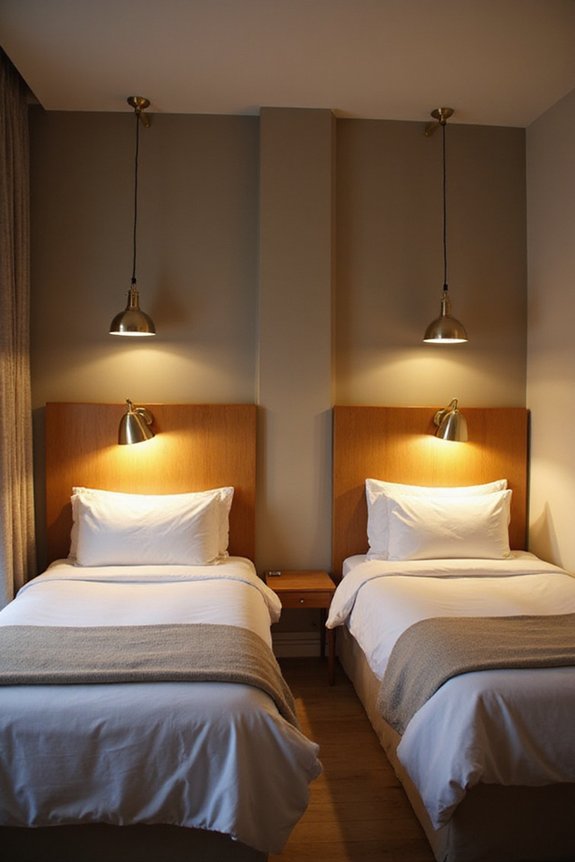
How can you prevent late-night reading from disturbing your twins’ sleep schedules? Install individual lighting solutions that let each child control their own brightness without affecting their sibling.
Consider adjustable desk lamps for homework stations, providing focused task lighting that reduces eye strain.
Wall-mounted reading lights with flexible necks work perfectly beside beds, allowing one twin to read while the other sleeps peacefully.
Clip-on LED lights offer portable options for books or tablets. Choose warm-toned bulbs that won’t disrupt natural sleep patterns. Dimmer switches give kids control over ambient lighting levels, creating personalized environments that support both study time and relaxation.
Create Shared Play Zones That Encourage Cooperation
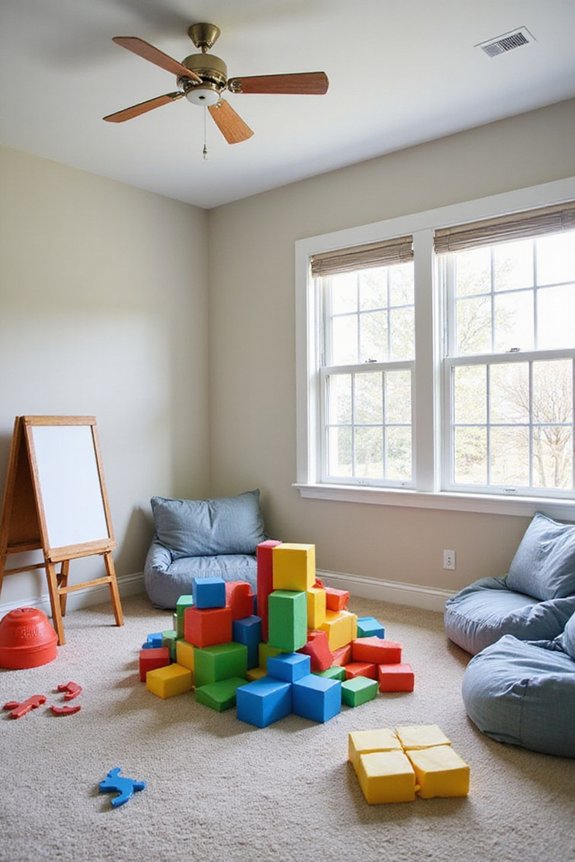
Successful twin bedrooms often feature designated play areas where siblings naturally learn to share, negotiate, and collaborate. You’ll want to establish zones that promote teamwork rather than competition.
- Central carpet or rug – Creates a defined space for building blocks, puzzles, and floor games
- Low shared toy storage – Accessible bins and shelves that both children can reach independently
- Activity table with two chairs – Perfect for crafts, drawing, and board games requiring cooperation
- Reading nook with large cushions – Encourages storytelling and quiet activities together
These shared spaces teach valuable social skills while maximizing your room’s functionality.
Design Coordinated Closet Systems With Personal Sections
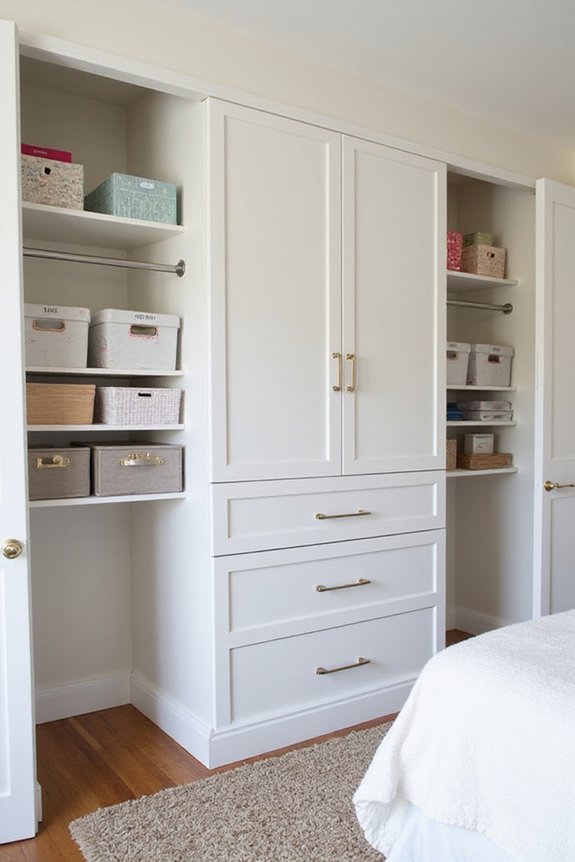
While shared play zones foster cooperation, each twin needs personal space to call their own—and the closet system offers the perfect opportunity to balance coordination with individuality. Design matching organizational units but assign each child their own designated sections. Use color-coded hangers, bins, or labels to clearly define ownership boundaries.
Install double rods at appropriate heights for growing kids, with personalized shoe racks below. Consider mirrored doors to expand visual space while maintaining the coordinated aesthetic. Add individual hooks for special items like backpacks or favorite jackets, ensuring both twins feel ownership over their storage areas.
Conclusion
Picture your twins’ faces lighting up as they step into their perfectly balanced sanctuary – each child claiming their personalized corner while enthusiastically planning adventures in shared spaces. You’ve crafted more than just a bedroom; you’ve built a harmonious world where individuality thrives alongside sibling bonds. Watch as bedtime battles transform into peaceful routines, and morning chaos melts into organized excitement. Your thoughtful design choices have created childhood memories that’ll last forever.

